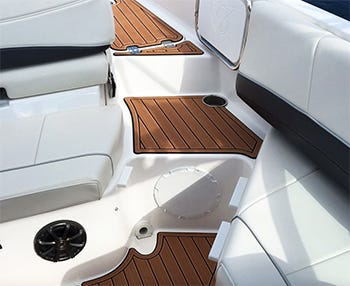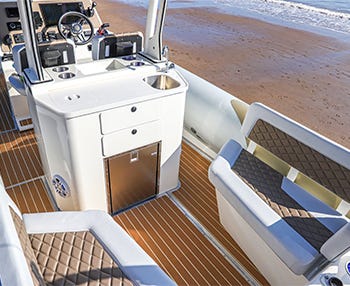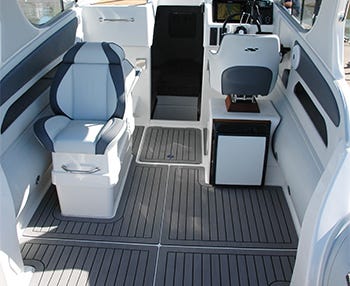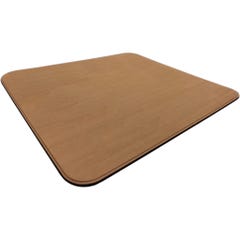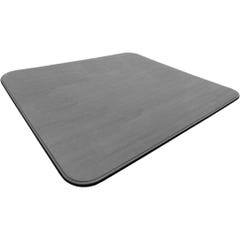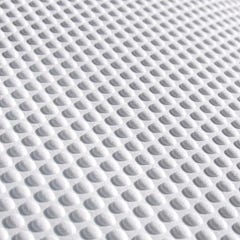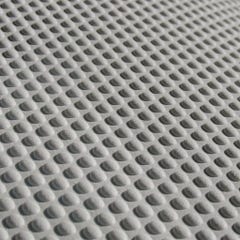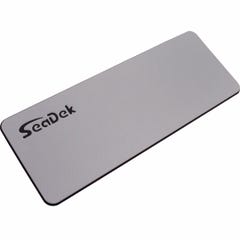Marine Foam Decking
March 07, 2023 7 min read


For years after it first hit the market in the U.S. in 2004, SeaDek was to marine foam decking what Q-Tips are to cotton swabs or Frisbees are to flying discs.
Now, although SeaDek remains the most recognizable name in foam decking, there’s plenty of competition: MarineMat, OceanGrip, GatorStep, AquaTraction, Hydro-Turf, TopDek, DEKit and plenty more brand names, plus countless no-name knockoffs sold on Amazon and Ebay.
Contents
- 1. Navigating the Diverse World of Marine Foam Decking
- 2. The Original Marine Decking
- 3. PE Decking Material
- 3.1 Strength Beneath your Feet
- 4. The Blend of EVA and PE
- 5. The Differences Between Marine Decking
- 5.1 UV Resistance and Adhesive Quality
- 6. Shark Deck with Boat Outfitters
- 7. How to Get the Results You Want
Navigating the Diverse World of Marine Foam Decking
You might assume, given the obvious similarities between not only the products themselves but even their names, that they’re all fundamentally the same stuff — the marine flooring equivalent of Sprite, 7-Up and Sierra Mist. But you’d be wrong.
In fact, there are two distinct kinds of foam decking: ethylene-vinyl acetate (EVA), polyethylene (PE), as well as various blends of the two materials, each with its own advantages and disadvantages
The Original Marine Decking
The first commercially available marine-specific foam decking products were made of straight EVA foam with UV inhibitors added to prolong service life.
EVA made — and still makes — a great boat decking material. It’s springy and cool-feeling underfoot, soft to the touch, lightweight, stain resistant, relatively tough and doesn’t absorb water. The same qualities that make EVA feel great under your feet!
That’s not to say that EVA isn’t a good decking material. Everything is a tradeoff, and EVA trades longevity and toughness for softness and rebound. For boats that see relatively little use and/or boats that are used mainly for cruising or boarding/skiing instead of fishing or hunting, EVA is great.
PE Decking Material
Soon, in search of a more durable foam decking material, companies began experimenting with PE. Among them was Ultralon, a well-established, New Zealand-based manufacturer of EVA and PE foams used around the world for applications ranging from ski boot liners to concrete expansion joints to prosthetics.
Strength Beneath your Feet
Ultralon, says Patrick Barberet, the company’s U.S. Business Unit Manager and an avid New England boater and offshore fisherman, found their PE decking offered a tougher and more stain-resistant material than others in the market.
That was primarily because of its very fine cell structure and increased density — upwards of 140 kg per cubic meter, as opposed to 90 to 100 kg per cubic meter for most EVA decking products. The tradeoff for the added durability, of course, was a less “cushy” feel.
The denser PE felt harder underfoot than EVA, didn’t rebound as quickly, and didn’t feel as cool to the touch on hot days. (As a general rule, the more aerated a foam is, the cooler it feels to the touch.)
Still, the superior resistance to wear and tear was hard to argue with, and Ultralon’s first-generation marine decking, U-Dek 140, was a straight PE product
The Blend of EVA and PE
In pursuit of the perfect balance of springiness and durability, most marine foam decking companies now use various blends of EVA and PE. For example, Ultralon’ s newest decking product, U-Dek High Performance, is “still PE-driven,” says Barberet, but also contains EVA for added rebound and stability.
It remains denser, though, at more than 140 kg per cubic meter. SeaDek, Marine Mat, DEKit and GatorStep also say their products are EVA/PE blends
This is a competitive business and most companies keep their formulations close to the vest.
Especially in the case of EVA/PE blends, you’re not likely to learn what exactly is in a given decking material. On the other hand, it’s certainly worth asking your sales person or installer whether their decking material is EVA, PE, or a blend.
The Differences Between Marine Decking
The type of material used isn’t the only difference between the various marine decking products. There are other factors to keep in mind too.
Density is determined not just by the type of material, but also by the amount of blowing agent used to manufacture the foam. All else being equal, denser decking is firmer, tougher, heavier and less cool to the touch on hot days than less dense decking.
Purity refers to the amount of fillers added during the manufacturing process. Using fillers keeps costs down but can lead to tiny voids and imperfections that make the foam more absorbent and susceptible to staining.
Many popular decking materials are made up of more than one layer of foam, usually of different colors. Decking that features a pattern of some kind is made by cutting through the top layer to expose the differently colored second layer.
In some products, the layers are laminated with glue, while in others they are heat-laminated. Heat-lamination reduces weight by eliminating glue and allows for cleaner and easier cutting.
UV Resistance and Adhesive Quality
UV resistance is dependent on many factors and is a major differentiator among decking products. Without UV inhibitors, EVA/PE foam won’t last long in the sun. As with foam formulations, you’re not likely to get any specifics about UV resistance from manufacturers.
Instead, talk to owners with real-world experience, taking into account the amount of sun exposure their boats get. You simply can’t compare the performance of marine decking on a boat that spends 99% of its hours in climate-controlled storage, with decking on a boat that lives year-round in an uncovered slip.
Adhesive quality also varies. Most companies now use a high-strength, pressure-activated peel-and-stick adhesive.
Shark Deck with Boat Outfitters
Some foam decking companies manufacture their own foam; others source their foam elsewhere. The Shark Deck material that Boat Outfitters sells, for example, is sourced from Ultralon and is the same product as Ultralon’s U-Dek High Performance.
Although it doesn’t enjoy widespread name recognition among U.S. boaters, Ultralon has in fact been around since long before anybody thought of sticking foam sheets on boat decks; the company has been manufacturing closed-cell cross-linked foams for 50+ years; the company has been manufacturing closed-cell cross-linked foams for 50+ years.
In the U.S., Ultralon doesn’t pursue the consumer market but instead supplies material to companies like Boat Outfitters, which sell it under their own brands.
How to Get the Results You Want
With a new brand hitting the market seemingly every month, choosing foam decking for your boat can get confusing.
Ultralon’s Barberet offers a few tips to keep in mind while shopping:
Go with a trusted name. There are very real differences not just in the formulations of the different brands, but also in their purity, their resistance to UV and heat, and their adhesion.
Go with a trusted name, but remember that in some cases, like Shark Deck, a relatively unknown brand name might in fact be a time-tested product. Always ask about the warranty.
Ask questions. Is the decking EVA, PE or a blend? Are the layers glued together or heat-laminated? Did the company manufacture the material themselves, or source it elsewhere? Are there any boats in your area you can look at that have had the product installed for a few years?
Get the product in your hands. There are big differences between foam decking brands in terms of softness, springiness, density and durability. Just holding a piece of material in your hands can tell you a lot. Most companies sell or give away small samples.
Pick a good fabricator/installer. For more than small, simple pieces like helm pads, cooler toppers, fish rulers and step pads, pay a professional to scan your boat and design, cut and install your decking.
Experience matters here, and quality fabrication and installation are just as important as the decking itself.
If you install it yourself, focus on the prep. As with many things, the prep work is the most important part of installing foam decking. Thoroughly clean the area where the decking will go to remove all grease and oil.
Remember that most brands use pressure-activated adhesive, meaning it doesn’t get sticky until it’s pressed down hard. If you’re working on a walkable surface, just walk over the whole area of decking, using your body weight to activate the adhesive.
Then, if at all possible, keep the decking out of the sun for 24 to 48 hours.

